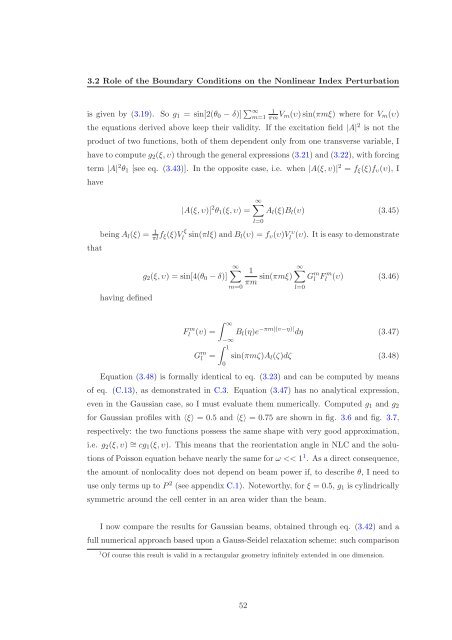Solitons in Nonlocal Media
Solitons in Nonlocal Media
Solitons in Nonlocal Media
Create successful ePaper yourself
Turn your PDF publications into a flip-book with our unique Google optimized e-Paper software.
3.2 Role of the Boundary Conditions on the Nonl<strong>in</strong>ear Index Perturbation<br />
is given by (3.19). So g1 = s<strong>in</strong>[2(θ0 − δ)] ∞<br />
m=1 1<br />
πm Vm(υ)s<strong>in</strong>(πmξ) where for Vm(υ)<br />
the equations derived above keep their validity. If the excitation field |A| 2 is not the<br />
product of two functions, both of them dependent only from one transverse variable, I<br />
have to compute g2(ξ, υ) through the general expressions (3.21) and (3.22), with forc<strong>in</strong>g<br />
term |A| 2 θ1 [see eq. (3.43)]. In the opposite case, i.e. when |A(ξ, υ)| 2 = fξ(ξ)fυ(υ), I<br />
have<br />
that<br />
|A(ξ, υ)| 2 θ1(ξ, υ) =<br />
∞<br />
Al(ξ)Bl(υ) (3.45)<br />
l=0<br />
be<strong>in</strong>g Al(ξ) = 1 ξ<br />
πlfξ(ξ)V l s<strong>in</strong>(πlξ) and Bl(υ) = fυ(υ)V υ<br />
l<br />
hav<strong>in</strong>g def<strong>in</strong>ed<br />
g2(ξ, υ) = s<strong>in</strong>[4(θ0 − δ)]<br />
F m<br />
∞<br />
l (υ) =<br />
−∞<br />
G m l =<br />
1<br />
0<br />
∞<br />
m=0<br />
1<br />
πm s<strong>in</strong>(πmξ)<br />
(υ). It is easy to demonstrate<br />
∞<br />
l=0<br />
G m l<br />
m<br />
Fl (υ) (3.46)<br />
Bl(η)e −πm|(υ−η)| dη (3.47)<br />
s<strong>in</strong>(πmζ)Al(ζ)dζ (3.48)<br />
Equation (3.48) is formally identical to eq. (3.23) and can be computed by means<br />
of eq. (C.13), as demonstrated <strong>in</strong> C.3. Equation (3.47) has no analytical expression,<br />
even <strong>in</strong> the Gaussian case, so I must evaluate them numerically. Computed g1 and g2<br />
for Gaussian profiles with 〈ξ〉 = 0.5 and 〈ξ〉 = 0.75 are shown <strong>in</strong> fig. 3.6 and fig. 3.7,<br />
respectively: the two functions possess the same shape with very good approximation,<br />
i.e. g2(ξ, υ) ∼ = cg1(ξ, υ). This means that the reorientation angle <strong>in</strong> NLC and the solu-<br />
tions of Poisson equation behave nearly the same for ω
















